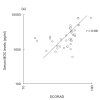Serum macrophage-derived chemokine (MDC) levels are closely related with the disease activity of atopic dermatitis
- PMID: 11876749
- PMCID: PMC1906347
- DOI: 10.1046/j.1365-2249.2002.01727.x
Serum macrophage-derived chemokine (MDC) levels are closely related with the disease activity of atopic dermatitis
Abstract
Atopic dermatitis (AD) is a chronic and relapsing inflammatory skin disease characterized by the predominant infiltration of T cells, eosinophils and macrophages in lesional skin. Recently, macrophage-derived chemokine (MDC)/CCL22, a CC chemokine, was identified as a selective chemoattractant for CC chemokine receptor 4 (CCR4)-expressing cells, in addition to thymus and activation-regulated chemokine (TARC). We have previously reported that serum TARC levels correlate with the severity of AD. In this report, we investigated the participation of MDC in AD. First, we measured serum MDC levels in 45 patients with AD, 25 patients with psoriasis vulgaris and 25 healthy controls. Serum MDC levels in AD patients were significantly higher than those in healthy controls and psoriasis patients. Furthermore, the increases in serum MDC levels in AD patients were greater in the severely affected group than in the moderate or mild groups. We compared serum MDC levels in 11 AD patients, before and after treatment, and observed a significant decrease after treatment. Moreover, the serum MDC levels significantly correlated with the Scoring AD (SCORAD) index, serum soluble (s) E-selectin levels, serum soluble interleukin-2 receptor (sIL-2R) levels, serum TARC levels and eosinophil numbers in peripheral blood. Our study strongly suggests that serum MDC levels have a notable correlation with disease activity and that MDC, as well as the CC chemokine TARC, may be involved in the pathogenesis of AD.
Figures



Similar articles
-
Significant elevation of serum levels of eotaxin-3/CCL26, but not of eotaxin-2/CCL24, in patients with atopic dermatitis: serum eotaxin-3/CCL26 levels reflect the disease activity of atopic dermatitis.Clin Exp Immunol. 2003 Nov;134(2):309-13. doi: 10.1046/j.1365-2249.2003.02273.x. Clin Exp Immunol. 2003. PMID: 14616792 Free PMC article.
-
Thymus and activation-regulated chemokine in atopic dermatitis: Serum thymus and activation-regulated chemokine level is closely related with disease activity.J Allergy Clin Immunol. 2001 Mar;107(3):535-41. doi: 10.1067/mai.2001.113237. J Allergy Clin Immunol. 2001. PMID: 11240957
-
Effect of an antiallergic drug (Olopatadine hydrochloride) on TARC/CCL17 and MDC/CCL22 production by PBMCs from patients with atopic dermatitis.J Dermatol Sci. 2004 Dec;36(3):165-72. doi: 10.1016/j.jdermsci.2004.09.001. J Dermatol Sci. 2004. PMID: 15541638 Clinical Trial.
-
Regulation of macrophage-derived chemokine (MDC, CCL22) production.Crit Rev Immunol. 2002;22(2):105-14. Crit Rev Immunol. 2002. PMID: 12433129 Review.
-
Thymus and activation-regulated chemokine as a clinical biomarker in atopic dermatitis.J Dermatol. 2014 Mar;41(3):221-9. doi: 10.1111/1346-8138.12440. J Dermatol. 2014. PMID: 24628072 Review.
Cited by
-
Efficacy and Potential Mechanisms of Naringin in Atopic Dermatitis.Int J Mol Sci. 2024 Oct 15;25(20):11064. doi: 10.3390/ijms252011064. Int J Mol Sci. 2024. PMID: 39456844 Free PMC article.
-
Efficient Use of a Crude Drug/Herb Library Reveals Ephedra Herb As a Specific Antagonist for TH2-Specific Chemokine Receptors CCR3, CCR4, and CCR8.Front Cell Dev Biol. 2016 Jun 7;4:54. doi: 10.3389/fcell.2016.00054. eCollection 2016. Front Cell Dev Biol. 2016. PMID: 27376063 Free PMC article.
-
Atopic Dermatitis Management: from Conventional Therapies to Biomarker-Driven Treatment Approaches.Biomol Ther (Seoul). 2025 Sep 1;33(5):813-829. doi: 10.4062/biomolther.2025.081. Epub 2025 Aug 19. Biomol Ther (Seoul). 2025. PMID: 40827120 Free PMC article. Review.
-
Effect of Sopoongsan on Skin Inflammation and Hyperlocomotion in Socially Isolated Mice with Atopic Dermatitis.Evid Based Complement Alternat Med. 2022 Sep 16;2022:3323201. doi: 10.1155/2022/3323201. eCollection 2022. Evid Based Complement Alternat Med. 2022. PMID: 36159556 Free PMC article.
-
Significant elevation of serum levels of eotaxin-3/CCL26, but not of eotaxin-2/CCL24, in patients with atopic dermatitis: serum eotaxin-3/CCL26 levels reflect the disease activity of atopic dermatitis.Clin Exp Immunol. 2003 Nov;134(2):309-13. doi: 10.1046/j.1365-2249.2003.02273.x. Clin Exp Immunol. 2003. PMID: 14616792 Free PMC article.
References
-
- Hanifin JM, Rajka G. Diagnostic features of atopic dermatitis. Acta Derm Venerol (Stock) 1980;92(Suppl.):44–7.
-
- Leung DYM. Atopic dermatitis: immunobiology and treatment with immune modulators. Clin Exp Immunol. 1997;107(Suppl.):25–30. - PubMed
-
- Furue M, Ohtsuki M, Ogata F, et al. Responsiveness to interleukin 4 and interleukin 2 of peripheral blood cells in atopic dermatitis. J Invest Dermatol. 1991;96:468–72. - PubMed
-
- Hirai S, Kageshima T, Tsujisaki M, et al. Soluble intercellular adhesion molecule-1 and soluble E-selectin levels in patients with atopic dermatitis. Br J Dermatol. 1996;134:657–61. - PubMed
Publication types
MeSH terms
Substances
LinkOut - more resources
Full Text Sources
Other Literature Sources

